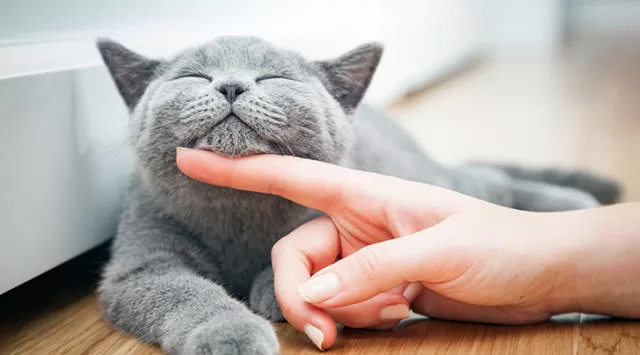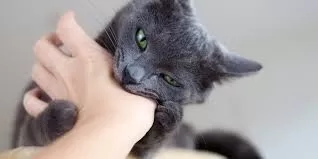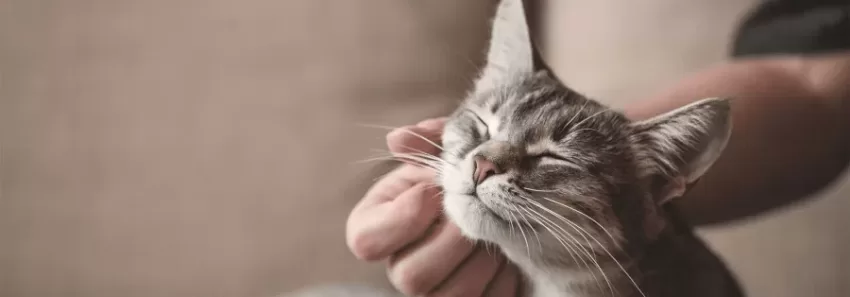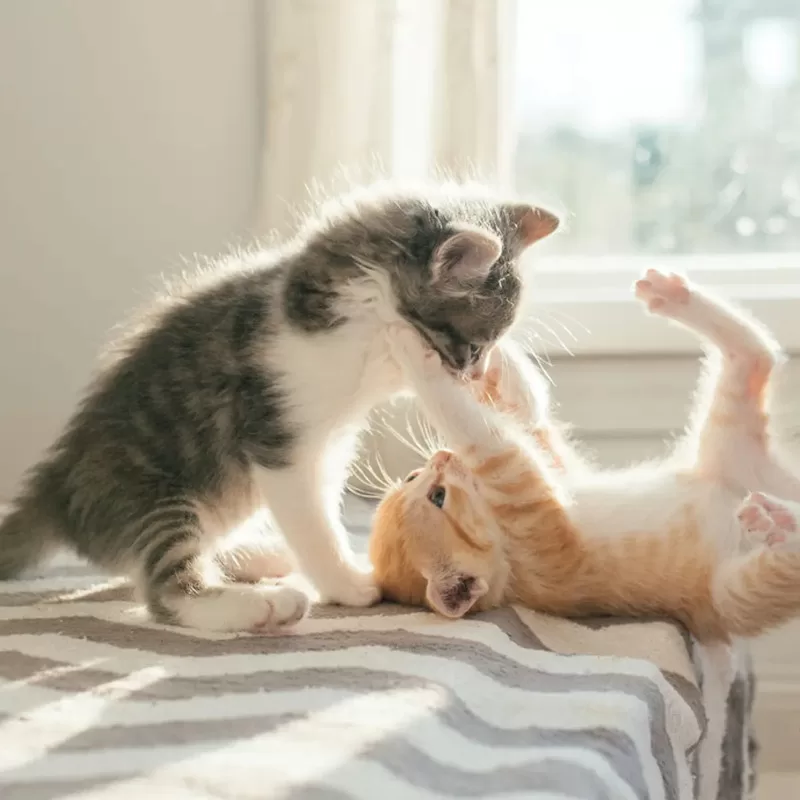Introduction to cat behavior
Did you know that cats have unique and fascinating behavior? Understanding the behavior of these animals is essential to meet their needs and improve coexistence with them. During this step, we will explore how cats socialize, interact with their family and communicate through body language.
When it comes to grooming, cats are known for meticulously grooming themselves. In addition, your physical state and muscles play an important role in your daily activity. Before understanding everything about cat behavior, it is important to recognize that each individual lives according to their own characteristics.
Throughout this guide, we’ll delve into the world of felines to find out what’s behind the peculiar attitudes of our furry friends. So, get ready to learn more about cat behavior and be surprised by the curiosities that await you!
How is the character of a cat formed?

A cat’s character is influenced by genetic factors and early experiences. The feline personality is unique to each individual, shaped by their individual history.
Genetic influence on the character of the cat
Genes play an important role in shaping a cat’s character. Just as humans inherit physical traits and behavioral traits from their parents, cats are also influenced genetically. Some cats may be predisposed to be more sociable, while others may have more independent tendencies. These traits are passed down through the genes and can affect the animal’s temperament.
Early experiences and proper socialization
In addition to genetic influence, a cat’s early experiences have a significant impact on its behavioral development. During the first few months of life, proper socialization plays a key role in shaping the feline’s balanced character.
Exposure to different stimuli at this critical stage helps the kitten get used to different situations and interact with other animals and people. Gentle play, gentle handling, and contact with different environments help the puppy develop confidence and security in its surroundings.
unique personality
Every cat has a unique personality, just like us humans. Your individual history, including past experiences, current environment, and interpersonal relationships, shapes your character. Some cats can be more outgoing and sociable, while others are more shy and reserved.
It’s important to respect each cat’s individuality and understand that they have different needs. Some may prefer moments of quiet and privacy, while others love to play and interact constantly. Observing your cat’s behavior over time will help you understand its specific preferences and needs.
Conclusion
A cat’s character is formed by a combination of genetic factors and early experiences. Proper socialization from a young age helps to develop a balanced character in the feline. However, each cat has a unique personality, shaped by its individual history. By understanding these individual characteristics, we can provide a suitable environment for our feline friends, ensuring their well-being and happiness.
Behavior problems in cats

Behavior problems can arise when cats’ basic needs are not met. Felines have natural instincts that need to be satisfied so that they can feel safe and happy in their environment. When these needs are not met, it is common to observe problematic behavior in cats.
An important factor to consider is stress. Just like humans, cats can also suffer from stress and this can affect their behavior. Situations such as changes in routine, introducing new animals or people into the house, loud noises and lack of privacy can cause feline stress. This stress can manifest itself through unwanted behaviors such as excessive scratching on furniture, urinating outside the litter box, or aggression.
Boredom is also a trigger for behavioral problems in cats. Although cats are independent animals, they still need mental and physical stimulation to stay healthy and content. The lack of environmental enrichment can lead to behaviors such as meowing excessively, playing aggressively or even developing food compulsion.
Identifying the underlying causes of behavior problems is critical to finding effective solutions. Each case is unique and requires an individual approach. Observing the cat’s environment, its interaction with other animals or people in the household, and analyzing possible recent stressful events can help to understand what is triggering the unwanted behavior.
In some cases, the presence of other health problems may be related to the cat’s behavior. Illnesses such as urinary infections or dental problems can cause discomfort and lead the cat to adopt an aggressive posture or avoid social interactions. Therefore, it is important to rule out any medical issues before exclusively treating the behavior.
There are different approaches to dealing with behavior problems in cats. One is to use positive reinforcement techniques to encourage desired behaviors and discourage unwanted ones. For example, if a cat is scratching furniture, providing appropriate scratching posts and rewarding the cat when it uses them correctly can help redirect this behavior.
In addition, offering an enriched environment for the cat is also essential. This includes providing interactive toys, vertical scratching posts, hiding places and raised areas for him to explore and exercise.
The unique behavior of cats and control of the environment

Cats are territorial animals that have an intrinsic need to control their environment in order to feel safe. Unlike other pets such as dogs, felines have a strong connection to their personal space and need to set clear boundaries within it.
Offering scratching posts is one of the most effective ways to help cats take control of their space. Felines have a natural habit of sharpening their nails and marking territory through the act of scratching. By providing a suitable scratching post, you are offering your cat a specific area where he can engage in this natural behavior without damaging furniture or carpets in the house. In addition, scratching posts also provide a comfortable place to rest, as many have soft surfaces where cats can settle.
Another important way to help control a cat’s environment is to provide comfortable beds and elevated places for them to settle down. Felines love to have high points where they can observe everything around them. This goes back to their wild instincts when they needed to watch their prey and avoid predators. By providing climbing shelves or towers, you are providing your cat with a safe and quiet place to relax while maintaining visual control of the environment.
In addition, it is essential to separate areas for feeding, resting and eliminating cats. Felines are extremely organized animals and establish different “zones” within their territory. By providing separate spaces for each of these activities, you are respecting their need for control over these important aspects of daily life.
For feeding, it is recommended to use specific feeders for cats, which can be placed in strategic places in the house. This ensures that the cat feels comfortable and safe during meals, avoiding disputes with other animals or external interference.
As for rest, it is important to offer soft pillows or beds in quiet places and away from busy areas of the house. Thus, the cat will be able to relax without interruptions and will have its own space to recharge its energies.

Finally, it is essential to provide clean and accessible litter boxes for cat disposal. These animals are very demanding about hygiene and need a location.
Cats are territorial animals by nature and have different ways of marking and protecting their territory. Understanding the signs and behaviors related to feline territorial defense is essential to promote a harmonious home environment. In this article, we’ll discuss some of these signs and how to interpret them.
Facial markings, sprayed urine, and scratching are typical signs of feline territorial marking.
When it comes to marking territory, cats have some very distinctive strategies. One of them is facial tagging. Felines have facial glands that secrete pheromones, chemicals that function as messages to other cats. When they rub their faces on objects or people, they are leaving their mark through these pheromones.
Another common sign of territorial marking is sprayed urine. Cats have glands in their mouths that produce a specialized liquid called spray urine. They can spray this urine in strategic places to mark their territory. This behavior usually occurs when there is a threatening presence or when they want to attract reproductive partners.
In addition, scratches also play an important role in marking the territory of cats. When scratching vertical or horizontal surfaces, they leave visual and olfactory marks from the glands present in the paws. This is a way of communicating to other cats that that space is occupied and must be respected.
Cats can display aggressive behaviors when they feel threatened in their territory.
When a cat feels threatened in its territory, it may exhibit aggressive behavior as a form of defense. This is because felines are territorial animals and need to protect their space. Some signs of aggression include:
- Tense body posture, with arched body and bristling hair.
- Growls, hisses or grunts.
- Staring and dilated pupils.
- Physical aggression, such as biting and scratching.
If you notice these signs in your cat, it’s important to give him space and avoid any kind of confrontation. Try to identify the cause of the discomfort so that it can be properly addressed. Remember that every cat is unique and may react differently to stressful situations.
Healthy habits for a balanced cat
Adequate food, regular exercise and mental stimulation are essential for a cat’s well-being. Providing interactive toys and play sessions helps keep cats active and happy. Establishing consistent sleeping, feeding, and grooming routines contributes to the emotional stability of cats.
A healthy diet is essential to ensure that your cat has a balanced life. Be sure to offer balanced food that meets your feline’s nutritional needs. It is important to choose quality feed that is specific to the age and physical condition of the animal. Also, avoid giving your cat human foods, as many can be toxic to them.
Regular exercise also plays a crucial role in a cat’s health. They need to expend energy on a daily basis to avoid problems like obesity and unwanted behaviors. Playing with balls, feathered wands or even chasing games will help keep cats active. In addition, providing scratching posts and climbing is also important to encourage physical exercise.
Mental stimulation is another essential part of a balanced cat’s routine. Felines are curious animals by nature and need regular mental stimulation. Offer interactive toys that challenge your cat to find hidden rewards such as treats. Also, take time to play with your cat, encouraging him to chase objects or hunt for toys.
Establishing consistent routines is also important for maintaining emotional stability in cats. They are animals of habit and feel more secure when they know what to expect in their day-to-day lives. Maintain regular schedules for meals, sleep, and basic care such as brushing and cleaning the litter box. This will help reduce stress and give your cat a sense of security.
In summary, to ensure healthy behavior in cats, it is essential to offer adequate nutrition, promote regular exercise and mentally stimulate cats. Establishing consistent routines also contributes to the emotional stability of these animals. Always remember to dedicate time and attention to your cat, providing a safe and enriching environment for him to live happily and balanced.
Health is fundamental in the lives of our feline friends!
The mysterious behavior of cats

Cats have an independent and reserved nature, which can seem mysterious to humans. Unlike dogs, which are more sociable and expressive animals, felines have their own characteristics that often leave us intrigued by their behavior.
Behaviors such as chasing shadows, hiding in tight spaces, or watching intently are typical for cats. These attitudes can be interpreted in different ways by tutors, but they are all related to their curious and hunting nature. Cats are predators par excellence and these habits are part of their natural instinct.
Cats’ natural curiosity often leads to puzzling and unpredictable behavior. They love exploring every corner of the house in search of interesting stimuli. Therefore, it is not uncommon to see them investigating unknown objects or playing with simple everyday things, such as a ball of crumpled paper.
In addition, cats have very keen senses, which contributes to their peculiar behavior. Their eyes are able to see in the dark and detect minute movements. This ability allows them to be excellent nocturnal hunters. Therefore, when a cat fixes its eyes on something apparently invisible to us humans, it is likely that it is chasing an insect or even a floating particle in the air.
Cats also have their individual preferences and tastes. Each feline has its own peculiarities, and what may be pleasant for one cat may not be for another. Some cats love to have belly rubs, while others prefer just a pat on the head. It’s important to respect each cat’s preferences and understand that not everyone likes to be held or hugged.
On the other hand, cats can also show fear or discomfort in certain situations. They are sensitive animals and can be easily startled by loud noises, unfamiliar visitors or sudden changes in the environment. When a cat is scared, it is common for it to hide in tight spaces or try to escape the threatening situation.
The mysterious behaviors of cats always arouse our curiosity and make us want to discover their secrets. However, it is important to remember that each cat is unique and has its own personality. Carefully observing your feline’s behavior and understanding its particularities contributes to a harmonious coexistence between humans and pets.
Cat behavior towards humans
Cats establish emotional bonds with their guardians, but they also value their independence. Unlike dogs, felines have a more reserved and autonomous nature. However, that doesn’t mean they don’t care for their pet humans. Cats are animals capable of developing strong emotional bonds with the people who care for them.
Understanding the felines’ bodily expressions helps to interpret their emotions towards humans. Cats have their own body language, and learning to decipher it is key to understanding their intentions and feelings. For example, when a cat arches its back and bristles, it could be a sign of aggression or fear. When he purrs and kneads his paws, he demonstrates contentment and tranquility.
Respecting the cat’s personal space and offering positive interactions strengthens the bond between them. Just like us, cats also need moments of privacy and rest. It is important to allow the cat its own space in the house, with access to high places where it can feel safe. In addition, when interacting with the animal, it is essential to avoid sudden movements or invasive touches that could frighten or cause discomfort.
Contrary to the common belief that cats are too independent to care about their human guardians, many felines are extremely affectionate and show affection in a variety of ways. Some cats like to rub up against people’s legs, while others prefer to sleep close to their owner. These attitudes show that cats value human presence and want to establish an emotional connection.
It is important to note that each cat has its own personality and temperament. Some may be more sociable and extroverted, constantly seeking interaction with people. Others may be more reserved and prefer quiet moments. Therefore, it is essential to respect the individual characteristics of each feline.
In short, cats have a unique behavior towards humans. They establish emotional bonds, but also value their independence. Understanding their body expressions, respecting their personal space and offering positive interactions are key aspects to strengthening the bond between cats and their human tutors. Contrary to what many think, cats are animals capable of showing love and affection for their caregivers.
Conclusion on cat behavior
Cat behavior is fascinating and unique. A cat’s personality and character are shaped by a combination of genetic factors, life experiences and the environment in which they live. Behavior issues can arise in cats, but it’s important to understand the underlying causes and address them appropriately.
A crucial aspect of ensuring healthy behavior in cats is controlling their environment. They are territorial animals and need to feel secure in their space. Observing the cats’ territorial defense signals, such as urine marking or scratching, can help you understand their needs.
To promote balanced behavior in your cat, it is essential to establish healthy habits. This includes offering toys suitable for physical and mental stimulation, providing a balanced diet and creating consistent routines.
Despite their mysterious nature, cats can develop strong bonds with their humans. It is important to provide them with adequate attention, affection and interaction to strengthen this relationship.
In short, understanding your cat’s behavior is key to creating a harmonious environment for both of you. By observing their signs, needs and establishing healthy habits, you will contribute to your feline’s well-being.
Frequently Asked Questions (FAQs)
HOW CAN I PREVENT BEHAVIOR PROBLEMS IN MY CAT?
Avoiding behavior problems in cats involves providing an enriching environment with appropriate toys, offering a balanced diet, establishing consistent routines and providing attention and affection.
WHY DOES MY CAT MARK TERRITORY WITH URINE?
Marking their territory with urine is a natural behavior for cats to mark their space. It can occur in response to changes in the environment or as a way of communicating with other cats.
HOW CAN I STRENGTHEN THE BOND WITH MY CAT?
To strengthen the bond with your cat, dedicate time to play and interact daily. Offer affection and attention, respecting your feline’s individual limits.
MY CAT SCRATCHES FURNITURE. WHAT CAN I DO?
Cats have a natural need to scratch to keep their nails healthy and mark their territory. Provide suitable scratching posts to redirect this behavior and protect your furniture.
HOW CAN I MENTALLY STIMULATE MY CAT?
Mentally stimulate your cat through interactive toys, simulated hunting games and by making different areas of the house available for exploration.
Always remember to consult a veterinarian or feline behaviorist if you have specific questions or concerns about your cat’s behavior.
External References:
«Commercial types of food for cats»

